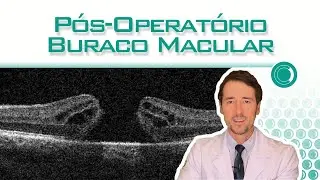Epiretinal Membrane After Vitrectomy: What Can Be Done?
What's up, guys?
This is Dr. Mário Bulla, and welcome once again to the “Retina e Vítreo” channel, the most complete retina channel on YouTube. Today, we're going to cover a very important topic, derived from a question from one of our followers: the epiretinal membrane after vitrectomy.
What is the Epiretinal Membrane?
The epiretinal membrane (ERM) is a thin, transparent layer that forms on the surface of the retina, usually in the macular region, which is responsible for central and detailed vision. This condition can occur spontaneously or, as is often observed, after surgical procedures such as vitrectomy.
Understanding Vitrectomy
Vitrectomy is a surgery that removes the vitreous humor, a jelly-like substance that fills the eye. This surgery is commonly performed to treat various eye conditions, including retinal detachment. During vitrectomy, the vitreous is replaced with a saline solution, gas or silicone oil to help keep the retina in place.
Epiretinal membrane after vitrectomy
After vitrectomy, it is relatively common for an ERM to develop. This is because the surgery provokes a scarring response in the retina, which can result in the formation of this membrane. The presence of a MER can lead to symptoms such as:
Metamorphopsia: Distortion of images, which appear wavy or crooked.
Blurred vision: Reduced clarity of vision.
Decreased visual acuity: Difficulty seeing fine details.
Diagnosis
The diagnosis of an epiretinal membrane is usually made through imaging tests, such as optical coherence tomography (OCT), which allows the structure of the retina to be visualized in detail. This test is essential for assessing the presence and severity of ERM.
Treatment
Not all epiretinal membranes require immediate treatment. The decision to intervene depends on the severity of the symptoms and the impact on the patient's quality of life. Treatment options include:
Regular Monitoring: For mild cases, where vision is not significantly compromised, the doctor may choose to monitor the condition on a regular basis.
Membranectomy surgery: In cases where MER causes significant distortion of vision, surgery to remove the membrane may be indicated. This procedure is often performed alongside vitrectomy and involves the use of delicate instruments to remove the membrane from the surface of the retina.
After surgery
Vision recovery after removal of an ERM can vary. Some patients report significant improvement, while others may have a slower recovery. Continuous follow-up with the ophthalmologist is crucial to monitor recovery and detect any complications.
Final considerations
Epiretinal membrane after vitrectomy is a treatable condition, but one that requires careful and individualized assessment. Each case is unique and should be discussed in detail with your ophthalmologist. If you have any questions about your condition or want to know more about treatment, don't hesitate to leave a comment. We're here to help!
Don't forget to leave a like, subscribe to the channel and follow our videos for more information on eye health and innovative treatments in the field of ophthalmology. See you in the next video!
Dr. Mário Bulla
Ophthalmologist - Retina and Vitreous
Retina e Vítreo - The Most Complete Retina Channel on YouTube
This video and its comments are not a substitute for a medical consultation and are for educational purposes only. They should not be used for decision-making purposes, which requires a face-to-face consultation with a specialist doctor.
Author:
Dr. Mário César Bulla
Cremers 28120
Ophthalmologist - Retinologist
www.clinicabulla.com.br
www.especialistaemretina.com.br
Instagram: @retina.bulla
Video URL: • Membrana epirretiniana após vitrectom...
@Retina e Vítreo
#retina
#ophthalmology
0:00 Is epiretinal membrane after vitrectomy normal?
1:05 What is retinal detachment?
1:50 Types of surgery for retinal detachment.
3:10 What is phacovitrectomy?
3:40 What is epiretinal membrane?































